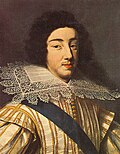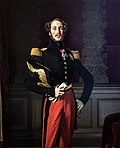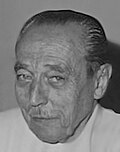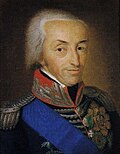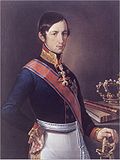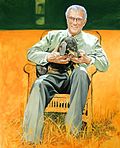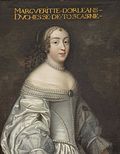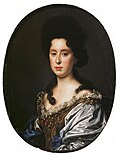| Name of descendant | Portrait | Birth | Marriages and issue | Death | Miscellaneous |
|---|
| Bourbons of France |
Louis XIV
1643—1715 | 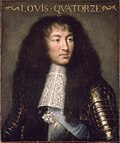 | 5 September 1638, son of Louis XIII and Anne of Austria | Maria Theresa of Spain
6 children
Françoise d'Aubigné, Marquise de Maintenon
no children | 1 September 1715 (aged 76) | |
| Louis, Dauphin of France |  | 1 November 1661, son of Maria Theresa of Spain and Louis XIV | Duchess Maria Anna Victoria of Bavaria
3 children | 14 April 1711 (aged 49) | |
| Louis, Duke of Burgundy |  | 16 August 1682, son of Louis, Dauphin of France and Maria Anna of Bavaria | Marie Adélaïde of Savoy
3 children | 18 February 1712 (aged 30) | |
Louis XV
1715—1774 |  | 15 February 1710, son of Louis, Duke of Burgundy and Marie-Adélaïde of Savoy | Marie Leszczyńska
10 children | 10 May 1774 (aged 64) | |
| Louis, Dauphin of France | 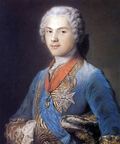 | 4 September 1729, son of Louis XV and Marie Leszczyńska | Maria Teresa Rafaela of Spain
1 child
Maria Josepha of Saxony
8 children | 20 December 1765 (aged 36) | |
Louis XVI
1774—1793 |  | 23 August 1754, son of Louis, Dauphin of France and Marie-Josèphe of Saxony | Marie Antoinette
4 children | 21 January 1793
(aged 38) | |
Louis XVII
1793–1795 |  | 27 March 1785
Palace of Versailles
son of Louis XVI and Marie Antoinette | never married | 8 June 1795
Paris Temple
(aged 10) | |
Louis XVIII
1795–1824 |  | 17 November 1755
Palace of Versailles
son of Louis, Dauphin of France and Marie-Josèphe of Saxony | Marie Josephine Louise of Savoy
14 May 1771
No children | 16 September 1824
Paris
(aged 68) | |
Charles X of France
1824–1836 |  | 9 October 1757, son of Louis, Dauphin of France and Marie-Josèphe of Saxony | Marie Thérèse of Savoy
3 children | 6 November 1836
(aged 79) | |
| Artois branch |
Louis Antoine, Duke of Angoulême
1836–1844 |  | 6 August 1775
Palace of Versailles
son of Charles X of France and Marie Thérèse of Savoy | Marie-Thérèse-Charlotte of France
June 1799
No children | 3 June 1844
Gorizia
(aged 68) | |
| Charles Ferdinand, Duke of Berry |  | 24 January 1778
Palace of Versailles
son of Charles X of France and Marie Thérèse of Savoy | Princess Caroline of Naples
1816
4 children | 14 February 1820
Paris
(aged 42) | |
Henri, Count of Chambord
1844–1883 |  | 29 September 1820
Tuileries Palace
son of Charles Ferdinand, Duke of Berry and Caroline Ferdinande Louise of Two Sicilies | Marie Thérèse of Austria-Este
November 1846
No children | 24 August 1883
Gorizia
(aged 63) | |
| Bourbons of Spain |
| Philip V of Spain | 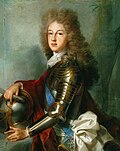 | 19 December 1683, son of Louis, le Grand Dauphin and Maria Anna Victoria of Bavaria | Maria Luisa of Savoy
Elisabeth Farnese
9 children | 9 July 1746 (aged 62) | |
| Charles III of Spain |  | 20 January 1716, son of Philip V and Elizabeth of Parma | Maria Amalia of Saxony
13 children | 14 December 1788 (aged 72) | |
| Charles IV of Spain |  | 11 November 1748, son of Charles III of Spain and Maria Amalia of Saxony | Maria Luisa of Parma
12 children | 20 January 1819 (aged 70) | |
| Ferdinand VII of Spain |  | 14 October 1784, son of Charles IV of Spain and Maria Luisa of Parma | Maria Antonia of Naples, Maria Isabel of Portugal, Maria Josepha Amalia of Saxony and Maria Christina of the Two Sicilies
2 children | 29 September 1833 (aged 48) | |
| Molina branch |
| Infante Carlos, Count of Molina |  | 29 March 1788
Madrid
son of Charles IV of Spain and Maria Luisa of Parma | Maria Francisca of Portugal
1816
Teresa, Princess of Beira
1838
2 children | 10 March 1855
aged 66 | |
Juan, Count of Montizón
1883–1887 |  | 15 May 1822
Royal Palace of Aranjuez
son of Infante Carlos of Spain and Infanta Maria Francisca of Portugal | Maria Beatrix of Austria-Este
6 February 1847
2 children | 21 November 1887
Hove
aged 65 | |
Carlos, Duke of Madrid
1887–1909 |  | 30 March 1848
Ljubljana
son of Juan, Count of Montizón and Maria Beatrix of Austria-Este | Margherita of Parma
4 February 1867
5 children | 18 July 1909
Varese
aged 61 | |
Jaime, Duke of Madrid
1909–1931 |  | 27 June 1870
Vevey
son of Carlos, Duke of Madrid and Margherita of Parma | never married | 2 October 1931
París
aged 61 | |
Alfonso Carlos, Duke of San Jaime
1931–1936 |  | 12 September 1849
London
son of Juan, Count of Montizón and Maria Beatrix of Austria-Este | Maria das Neves of Portugal
26 April 1871
1 child | 29 September 1936
Vienna
aged 87 | |
| Cádiz branch |
| Infante Francisco de Paula of Spain | 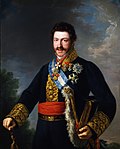 | 10 March 1794
Aranjuez
son of Charles IV of Spain and Maria Luisa of Parma | Princess Luisa Carlotta of Naples and Sicily
12 June 1819
11 children | 13 August 1865
Madrid
aged 71 | |
| Francis, Duke of Cádiz |  | 13 May 1822
Aranjuez
son of Infante Francisco de Paula of Spain and Princess Luisa Carlotta of Naples and Sicily | Isabella II of Spain
10 October 1846
12 children | 17 April 1902
Épinay-sur-Seine, France
aged 79 | |
| Alfonso XII of Spain |  | 28 November 1857
Madrid
son of Isabella II of Spain and Francis, Duke of Cádiz | Mercedes of Orléans
23 January 1878
No children
Maria Christina of Austria
29 November 1879
3 children | 25 November 1885
El Pardo
aged 27 | |
Alfonso XIII of Spain
1936–1941 |  | 17 May 1886
Madrid
son of Alfonso XII and Maria Christina of Austria | Victoria Eugenie of Battenberg
31 May 1906
7 children | 28 February 1941
Rome
aged 54 | |
Infante Jaime, Duke of Segovia
1941–1975 |  | 23 June 1908
Segovia
son of Alfonso XIII and Victoria Eugenie of Battenberg | Emmanuelle de Dampierre
4 March 1935
Rome
2 children | 20 March 1975
St. Gallen
aged 67 | |
Alfonso, Duke of Anjou and Cádiz
1975–1989 |  | 20 April 1936
Rome
son of Infante Jaime, Duke of Segovia and Emmanuelle de Dampierre | María del Carmen Martínez-Bordiú y Franco
8 March 1972
Royal Palace of El Pardo
2 children | 30 January 1989
Beaver Creek
aged 53 | |
Louis Alphonse, Duke of Anjou
1989–present |  | 25 April 1974
Madrid
son of Alfonso, Duke of Anjou and Cádiz and María del Carmen Martínez-Bordiú y Franco | Maria Margarita, Duchess of Anjou
5 November 2004
Caracas
3 children | | |







